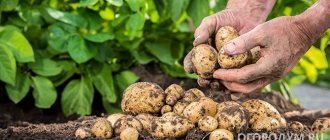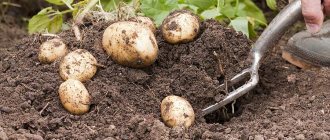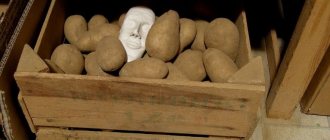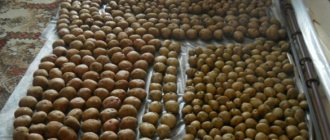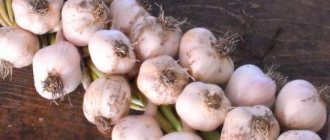In most regions of Russia, the potato harvesting period is gradually coming to an end. If there is nothing complicated in the process of harvesting potatoes, but everything related to storing root crops must be taken very seriously.
The shelf life of the vegetable depends on the correct storage location. Most often, root vegetables are stored in a cellar or basement. The storage space must be properly prepared so that the harvest lasts until spring and does not begin to rot.
Potato varieties for storage
Potatoes are the basis of people's nutrition, so everyone tries to stock up on them for the winter. This fastidious vegetable is rich in starch and water, so it reacts sensitively to storage conditions.
Heat, cold and high humidity are the main reasons why root crops rot. Experts believe that almost all varieties of potatoes can be stored.
Only the shelf life of each variety is different:
Advice. Before storing potatoes in the cellar, you need to prepare the tubers for laying.
A variety of varieties gives a higher percentage of crop storage. Optimal conditions are considered:
Advice. Failure to comply with these parameters leads to spoilage and sprouting of potatoes. If the temperature in the cellar is +7 or higher, the potatoes begin to sprout.
When it drops to 0, the starch in the tubers turns into sugar. And at sub-zero temperatures, the potatoes freeze and become unusable.
Potato selection
Only healthy potatoes are selected for long-term storage.
If you don’t have your own plot, and you buy potatoes for the winter, you need to do this in late autumn (October, November).
At this time, late varieties suitable for long-term storage are collected and sold. If potatoes are grown on a personal plot, root crops with a medium and late ripening period ( Atlant, Asterix, Picasso, Zhuravinka, Vesnyanka, etc.) are selected for storage in the cellar.
It is not recommended to store early ripening varieties . They are used primarily for food. It will be possible to keep such potatoes in the cellar only until the end of autumn.
Before putting vegetables into the basement, they must be dried and sorted . Rotten and cut tubers are removed.
Optimal storage mode
What temperature and humidity should be in the basement so that the root crops do not rot, sprout or freeze?
If the cellar is too warm, the potatoes begin to shrink, releasing moisture, and sprouts appear.
In a warm cellar, potatoes sprout quickly.
High humidity is also dangerous. Dampness promotes the appearance of fungal diseases, and potatoes begin to rot and deteriorate en masse.
Preparing the premises
The cellar must maintain a constant temperature regime.
If the storage conditions are observed, the potatoes are in a state of rest - they do not grow roots and do not freeze.
To avoid sudden changes in temperature , the room must be properly equipped. If the cellar is located separately from the living space, the risk of overheating is minimal. Falling snow helps maintain optimal temperatures.
When equipping the basement, you must adhere to the following recommendations :
Installation of supply and exhaust ventilation system
Preparing the cellar for storage
A set of measures aimed at minimizing the risk of rotting and disease of root crops will help to achieve maximum crop safety.
Storing potatoes in the cellar requires a set of preliminary measures:
Note. Any size cellar for storing potatoes requires mandatory preparation of compartments (bins). The process of making them is not complicated, you just need to follow the rules for their construction.
Common Mistakes
Improper handling of vegetables and violation of the rules for storing them worsens the taste of the vegetable and generally makes it unsuitable.
The most common errors associated with crop storage include the following:
- Storing damaged potatoes. A vegetable infected with pathogenic microorganisms is a source of infection of healthy tubers. This causes massive rotting. In this case, it is not possible to save the crop.
- Reluctance to sort through potatoes from time to time. Vegetables need to be sorted at regular intervals in order to promptly remove specimens affected by pathogenic microflora.
- Storing all types of potatoes together. It is necessary to sort out early, mid-season and late species.
- Poor drying of potatoes. After the harvest is harvested, it must be thoroughly dried, otherwise massive damage to the tubers by bacterial ring rot may occur.
- Lack of ventilation in the room. Under such conditions, the tubers quickly rot.
- Insufficient disinfection of the premises. Before moving vegetables into the storage room, be sure to treat the walls with whitewash material.
- Using tight containers. If too many potatoes are placed in a box or bag, individual tubers will experience strong pressure from neighboring ones and shrink. This leads to the formation of gray spotting.
This video talks about sorting potatoes, choosing the right container and place to store them:
To preserve potatoes from harvest until spring, you need to prepare both the place where they will be stored and the tubers themselves. Vegetables should be kept in optimal conditions of temperature and humidity, not subject to mechanical pressure, and inspected from time to time for rotting and other diseases.
0
0
Copy link
Skillful storage without a cellar
Not everyone has a basement, and the question of how to store potatoes without a cellar remains relevant.
The most common type of storage is pile:
A common storage method for high yields is a hole in the garden:
Storage rules
The most important requirement for how to properly store potatoes in a cellar is strict adherence to temperature rules (see What should be the temperature in the cellar: the best option).
Advice. It is mandatory to have a thermometer in the room. Having noticed an increase in temperature, you need to reduce it as quickly as possible by opening doors, windows, placing bottles of ice on the floor and shelves (read Do-it-yourself temperature regulator for the cellar: how to use it correctly).
During severe frosts, the temperature in the storage also decreases.
You can protect the potatoes by covering them, insulating them with straw, and warming the air with a small heater. The maximum height of the top layer of potatoes can be 1.2 - 1.3 meters.
Potatoes in bags, nets and in bulk
Common simple ways to properly store potatoes in the cellar are storing them in nets and bags:
You can also store potatoes in bags in the cellar:
Advice. The basic rule for storing potatoes in the cellar all winter is that they are deep enough. Only it contributes to a stable and constant temperature.
Storing potatoes in piles
The question of how to store potatoes in bulk in a cellar is considered the easiest.
This storage option does not require much effort and skillful practical skills:
Advice. Proper storage of potatoes in the cellar and extension of this period do not allow the use of plastic bags and bags. There is little air in such a container, which causes the vegetable to become damp and begin to rot.
All potatoes put aside for storage must be:
You can watch the rules for choosing potatoes for storage and the entire period of their preparation for storage in the video presented in our video catalogue.
Victor Martovich
Source
Storage containers
Potatoes, which after digging will be stored for about six months, must be placed in specially prepared containers.
You can store tubers in:
- Wooden boxes . This is the most common option for storing vegetables. When selecting boxes, you need to make sure that the boards are loosely knocked down. The top of the drawers should be open: this promotes good air exchange. 10-12 kg of tubers should be placed in each box. Containers should be placed on shelves or racks. The distance between them should be 10-15 cm. The bottom drawers should be at a distance of 15 cm from the floor for better air penetration to the vegetables.
- Plastic containers . This container is lightweight, so it can be carried without problems. Its walls and bottom with a mesh structure also ensure adequate air supply to the tubers.
- Mesh bags . You should not choose dense polypropylene bags, as they hardly allow air to pass through and contribute to potato rotting. Such containers are placed vertically or laid horizontally. In the latter case, you can lay the bag on top of the bag.
Preparing storage space
Careful preparation of the storage area extends the shelf life of products.
Basement or subfloor
If you plan to store your potato harvest in the basement or subfield of a private house, make sure that the room does not freeze in winter and does not warm up in the warm season. Thermal insulation is made according to the principle of a thermos.
The air in the underground should not stagnate. Air flow is provided by ventilation holes. Disinfection using sulfur bombs, lime or other preparations will help get rid of mold and bacteria in storage.
When making a pile, the potatoes are placed on the surface of a flat area and covered with heat-insulating material on top. There are also semi-aerial piles, when potatoes are laid out in a pit 25-30 cm deep. The height of the embankment is 90-100 cm.
The potatoes are insulated with a layer of straw (75-80 cm) and a layer of earth on top (up to 50 cm). To prevent rainwater from flowing inside, the ridge is covered with a gable gutter.
A hole for storing potatoes is dug in a high place so that water does not get in there. The depth of the pit is at least 2 m. Vegetables are laid out in a layer of 80-10 cm at the bottom of the recess. Covered with dry sand and earth on top.
When storing vegetables in pits, it is convenient to use a plastic or metal barrel. It is installed at the bottom of the pit, vegetables are laid and insulation is placed on top.
Foam plastic, fine straw laid in a dense layer, corn leaves and stalks are also suitable for insulation.
And if you use two barrels of different sizes, inserting one into the other, you will get a real thermos in which the crop is not afraid of any frost. The space between the walls of the barrels is filled with heat-insulating material.
Attention! Barrels and boxes installed in the pit will protect the crop from mice.
Such a small cellar can also be set up in a country house, garage or shed to make it convenient to get vegetables in winter. With the arrival of frost, the storage is additionally insulated on top with leaves, peat, and sawdust.
Trench
A trench for storing crops is a ditch up to 0.5 m deep, dug in a dry place. Potatoes are placed in such storage in dry weather. The trench is insulated in the same way as a pit, with several layers (straw, sawdust, peat and earth).
Advice. Insulate the trench from above with spruce branches. This will repel rodents.
A pile, a pit, and a trench are built on a hill so that the place is not flooded with water. In winter, holes and trenches are additionally covered with a thick layer of snow.
Where and how to store at room temperature in the house
In the house, containers with potatoes are placed in the coolest places: under the windows, near the door in the hallway, in the pantry.
Fresh leaves of rowan or wormwood will help protect vegetables from fungi and bacteria that cause rot. They are used to transfer the tubers in a bag. For every 50 kg of potatoes, about 1 kg of foliage is used.
Dry mint leaves help inhibit the germination process of tubers. They are poured in layers 1-2 cm thick at the bottom of the bag, in the middle and on top of the tubers.
Potatoes stored at home are periodically inspected and sorted. Vegetables with areas of rot are removed, and those that come into contact with rotten ones are eaten first.
Optimal storage conditions for potatoes
In order for potatoes to be stored for a long time, the following conditions must be met in the room:
- air temperature – +2..+5 degrees;
- air humidity - 80-90%;
- good ventilation, the air should not stagnate;
- the room should be dark.
Note! If the temperature is below normal, the potatoes will freeze; if the temperature is higher, they will begin to germinate. Excessively high humidity (above 90%) - rotting will begin, below - it will dry out and wrinkle. Storing tubers in the light will cause them to turn green, that is, they will produce a toxic substance such as solanine, and they will become unsuitable for food.
Preparing potatoes for storage
The preparation process begins with washing (if you want to store washed vegetables for the winter). This allows you to detect all potatoes with signs of disease and damage.
Important! If you decide to store washed potatoes, pay special attention to thoroughly drying the tubers after washing.
After washing or cleaning from lumps of adhering dirt, all potatoes are sorted into small, medium and large. Medium-sized potatoes last the longest. Small and large ones are stored worse. Damaged copies are stored separately and should not go into storage.
Tubers intended for planting in the spring are placed in a separate container.
Washed, sorted and inspected vegetables are laid out to dry in the shade or partial shade for several hours. Turn the potatoes over from time to time.
Storage containers
After drying, the tubers are placed in storage containers:
The filled container is placed in a cool place for several days to cool. After this, the harvest is transferred to the prepared storage.
What is rotting
From a chemical point of view, this is the process of decomposition of complex nitrogen-containing compounds due to the action of putrefactive microorganisms. Another name for this phenomenon is ammonification.
Reference
When rotting occurs, ammonia gas is released into the air. This substance is the source of the unpleasant odor that we smell from rotten vegetables. Rotten potato tubers cannot be eaten; they must be disposed of immediately.
During ammonification in plant tissues, increased evaporation of moisture and decomposition of nutrients - starch, sugar, proteins, etc. occur. Pathogens of rot (fungi and bacteria) enter tubers in various ways - brought from the fields along with particles of soil, stored in storage from the previous harvest. Improper storage conditions for vegetables contribute to the rapid progression of putrefactive processes.
Storage recommendations
Recommendations from experienced gardeners will help preserve the harvest until spring without loss.
Variety selection
Only late and mid-season varieties are stored for long-term storage. Early ripening potatoes are not suitable for winter storage. Even if optimal conditions are created, it will last no more than 2-3 months after digging.
The growth period of mid- and late-ripening varieties is from 90 to 140 days. They contain the maximum amount of carbohydrates and nutrients.
Popular late varieties include Picasso (Dutch selection), Temp (large-fruited variety), Nevsky (medium-fruited variety with round tubers), Nikulinsky (with medium-sized oval tubers), Zhuravinka (Belarusian selection, drought-resistant).
Careful sorting
Before storing vegetables in storage, they are carefully inspected and sorted. All specimens with signs of disease and damage to the skin are rejected.
Attention! Only tubers that are completely healthy and have no damage to the skin can remain for a long time.
Damaged potatoes are stored separately and eaten first.
Storage in small containers
Sorted and dried potatoes are laid out in small wooden boxes, plastic boxes or linen bags. This way the potatoes are better ventilated and less susceptible to spoilage.
Storing separately from other vegetables
It is better to store potato tubers separately from other vegetables. The only good neighbor for potatoes is beets. It absorbs moisture evaporated by the tubers.
The best varieties of potatoes for winter storage
Potato varieties of mid-late and late ripening are best suited for winter storage - the duration of the dormant period approximately corresponds to the length of the growing season.
The most popular potato varieties for winter storage (Middle zone and Moscow region)
| Variety and ripening period | Description of the variety | Descriptions of root vegetables |
| Picasso (late) | A productive variety of Dutch selection for the Moscow region and southern regions (up to 20 tubers in a nest), drought- and heat-resistant, rarely gets sick. | Oval beige root vegetables (from 100 g) with pink eyes. The pulp is creamy. |
| Zhuravinka (late) | An unpretentious variety of Belarusian selection, resistant to most potato diseases, including scab and late blight | Smooth tubers (from 100 g) with a red skin, the flesh when cut is yellow. |
| Asterix (late) | The Dutch selection variety is characterized by increased resistance to mechanical damage and long-term storage | Smooth root vegetables (about 100 g) with red skin and yellow flesh. |
| Lorch (mid-late) | A high-yielding variety with increased keeping quality of tubers, it is not afraid of late blight and cancer. | Large root vegetables (100-120 g) beige in color with white pulp. |
| Blueness (average) | An unusually productive (up to 500 kg per 1 acre) large-fruited variety, resistant to viruses and fungal diseases. | Large (from 150 g) smooth tubers of excellent taste, white in color with white pulp. |
Storing potatoes in the basement or cellar in winter
Since most summer residents have a potato harvest of tens and even hundreds of kilograms, to preserve its marketable appearance, certain conditions must be created in winter and other periods. Storing potatoes in winter, as well as carrots and beets, sometimes causes certain difficulties, which can lead to the loss of many harvested tubers. This is why it is so important to avoid mistakes in this process.
Preparation process
The process of preparing potatoes for storage begins immediately after removing them from the soil. It includes the following actions:
- the tubers directly on the site are scattered on the ground in one layer and are exposed to sunlight, as a result of which no harmful bacteria and fungi remain on them;
- drying allows the peel to become more dense, so the tubers need to be turned over with your hands several times so that ultraviolet radiation reaches the entire surface;
- after drying, the remaining soil will be easily cleaned, thanks to which potatoes with mechanical damage can be selected from the total harvest;
- the next stage is sorting: large specimens are selected for longer storage, medium potatoes will be suitable as planting material for the next year, and small potatoes will be used to feed farm animals;
- during sorting, all spoiled specimens and non-marketable potatoes are put aside;
- diseased vegetables affected by late blight, scab, wireworm, cancer and other diseases should be disposed of immediately and this should be done away from the site;
- the sorted material should be treated with any antifungal agent (phytosporin, bactofit or one of their analogues);
- then all the tubers need to be transferred to a shaded place, where they will lie for several days, so that excess moisture is removed from the surface of the peel;
- when it becomes dry enough, the tubers are placed in bags, nets, boxes and sent to storage.
Preparing the storage area
Most often, basements and cellars are used to store this crop. As a last resort, an underground or pantry is suitable (and only assertive people, with great desire and opportunity, allocate a place for potatoes on the balcony or at home). Vegetable storage must be properly prepared for the winter. First of all, it is thoroughly cleaned. To disinfect walls and ceilings, we use a solution of lime or an aqueous mixture of lime and copper sulfate. These substances perfectly protect against the development of pathogenic microorganisms. In some cases, gardeners and summer residents fumigate their premises with sulfur, but in recent years this method of disinfecting storage facilities has been used less and less, since it requires long-term ventilation of the premises.
We treat shelves, racks, drawers, panels, stairs, hoods, vents 2-3 times with a dark pink solution of potassium permanganate. After this, ventilate the room well so that all surfaces are completely dry. The storage must be well thermally and waterproofed.
Folk tricks
Experienced summer residents often use folk methods of preserving potatoes. This is a well-known folk method in which the leaves and grass of plants containing phytoncides are placed in a room with tubers. They suppress the growth and development of pathogenic microorganisms. These include fern, rowan, tansy, basil, peppermint, horseradish, and wormwood. You can also place branches of coniferous trees in the storage area with vegetables. Sprinkling the tubers with dry onion peels also prevents the development of pathogenic fungi and bacteria.
How to prepare a cellar
The optimal constant temperature is 2-4°C. Constant humidity is also extremely important - 80-90% - as well as protection from water ingress.
Attention! Since the tubers “breathe” and emit carbon dioxide, ventilation must be provided in the room.
The cleanliness of the cellar is of great importance, so it is pre-treated.
Treatment
All unnecessary things are thrown out of the cellar, garbage is removed, and the floor is swept. The shelves on which the boxes of potatoes will be stored are taken out into the sun and dried. They are then treated with antifungal drugs. The walls and ceiling are inspected for the presence of mouse and rat passages; if there are any, they are filled with cement. After this, the walls and ceiling are treated with lime.
After all these steps, the cellar is left open to dry for 3-4 days.
Preparing the storage container
If potatoes are stored in wooden boxes or pallets, they are inspected for damage and replaced with new ones if necessary. Then the boxes are cleaned of soil and other contaminants and washed with soapy water. After this they are dried in the sun.
The most common mistakes when storing potatoes for winter storage
Even for some experienced summer residents, storing potatoes can end in failure due to mistakes made when harvesting and trying to preserve this vegetable. The most typical of them include:
Potato varieties intended for storage
Many people make the mistake of thinking that any representatives of this culture hold up well in winter. Early ripening potatoes are absolutely not suitable for this lengthy process. It will persist only until November-December, and then the tubers will begin to wither or germinate. To do this, you need to choose varieties of medium and late ripening. They can be stored without problems until a new harvest is obtained. Good keeping quality is observed in the following potato varieties: Bernadette , Yavir , Chaika , Gatchinsky , Zhuravinka , Slavyanka , Nevsky , Atlant , Asterix , Red Scarlett , Folva , Kolobok , Saturna . Also, do not neglect local long-registered varieties of these vegetables, which are successfully used for long-term storage.
Laying low quality tubers
Potatoes left for many months must be intact (without mechanical damage), completely healthy (without signs of disease or rotting), and not damaged by pests. If a summer resident leaves low-quality tubers, after just a couple of months his entire crop may rot.
Placing together with other vegetables
Lack of necessary conditions
Failure to comply with the correct temperature and humidity conditions will certainly lead to significant loss of tubers.
Lack of regular audit
It is necessary to periodically sort through the potatoes, removing spoiled specimens and those that touched them. Even if there are no visible signs of disease, but fruit flies are visible, you need to carefully inspect the stocks and eliminate suspicious tubers.
Why potatoes are poorly stored: main mistakes
It often happens that you seem to have harvested the crop on time and correctly, prepared it and put it in the cellar or on the balcony for storage, but for some reason part of the crop has spoiled.
To prevent this from happening next time, we suggest that you familiarize yourself with possible errors in advance. At least this way you won't have to learn the hard way by losing part of your harvest.
So, the most common mistakes and blunders that can be made in the process of storing potatoes for winter storage:
Wrong variety (early ripening)
Not all varieties are suitable for long-term storage. Early varieties are intended exclusively for consumption as food or for a short stay in the cellar (1-2 months). No matter what conditions you create, early ripening potatoes will still begin to germinate, and at the same time lose their taste.
Thus, for storage you should choose only late and mid-late varieties, maximum mid-ripening. Extra-early, early and mid-early - for consumption only.
Poor quality tubers (damaged and diseased)
When storing potatoes, you should be very careful about the process of sorting and calibrating them. A few diseased tubers are enough to infect the entire crop. It must be remembered that only healthy potatoes can last the whole winter.
Important! Tubers with minor damage (any slight scratches or cuts received during digging and sorting) should be stored (albeit for a short time, they need to be consumed first), but they should be kept apart, separate from the whole ones.
Storing with other vegetables and fruits
Often, in order to save space in storage, inexperienced vegetable growers put all vegetables in one box, but in the case of potatoes, this should not be done.
You can and even need to store potatoes only with beets , which should be placed on top of the tubers. This proximity will benefit both vegetables, since the beets will absorb all the excess moisture, thereby protecting the potatoes from rotting.
By the way! Read about ways to store beets for a long time in this article .
Failure to comply with storage conditions
The consequence of violating the requirements for the premises (its temperature, humidity (ventilation) and illumination) will be damage to the crop.
Potatoes started to sprout
Advice! If you have problems with air circulation (the most common problem), try to at least ventilate the room in a timely manner.
If it is easy to comply with these conditions in a cellar or basement, then when storing crops in an apartment, on a balcony or loggia, this will be much more difficult. Therefore, if you decide to store potatoes without a cellar, then you should follow all recommendations for home storage.
Rare preventive examinations of tubers
If you don’t want to come one day and find that half of the potatoes have rotted, then periodically you need to carefully inspect and sort through the tubers, discarding the spoiled ones and those that were lying next to them (perhaps the disease simply has not yet manifested itself on them).
Note! Even though in appearance everything seems to be in order, if the potato has an unpleasant odor (rotten aroma) or small flies (fruit flies) are flying around - these are clear signs that there is a rotting tuber hidden somewhere, and its need to be found and removed from storage as soon as possible.
Video: 5 mistakes when storing potatoes
We hope you now have a clear understanding that sorting and preparing tubers, processing them before storing, as well as maintaining optimal storage conditions for harvested vegetables will help improve the quality of stored potatoes.
Video: how to store potatoes in winter
Preparing potatoes for storage in the basement or cellar
Before storing potatoes in storage, a number of manipulations should be performed, on which their safety largely depends. These include:
Cleaning tubers from soil residues and various impurities
Pieces of soil should be removed manually and very carefully so as not to damage the integrity of the skin of the root crop. It is important to remember the rule: dug up potatoes should not be washed or wet.
Sorting
It is necessary not only for removing damaged, diseased, frozen tubers, but also for separating small potatoes from large ones. Also, the entire crop is sorted to identify the highest quality tubers left for planting next season. Before planting in the cellar, planting potatoes are left in sunlight for several days so that they turn green. This preparation makes the tubers more resistant to storage. It is best to place potatoes of different categories separately.
Typically, vegetables intended for consumption are divided into piles according to the time of use. So, for the medium term, large tubers are chosen, which are well preserved only until December-January. In the future, voids may form in them. Every month they lose their nutritional and taste properties. Medium tubers can be stored for a long time. They can preserve their nutritional and taste properties of vegetables until the next harvest. Small and damaged tubers are used as quickly as possible, since they dry out, rot or wrinkle over time. All potatoes should be dry, have a firm skin and no noticeable sprouts. It is unacceptable to send crushed tubers affected by late blight or rot for storage.
Tuber preparation
To prevent the harvest from spoiling, you need to properly prepare it for subsequent storage. You should pay attention to the following recommendations:
- Drying and washing. The dug up tubers should lie in the sun for 3-4 hours and dry thoroughly. After this, they should be placed in a cool room where the sun's rays do not penetrate, so that the peel of the vegetables becomes rough. If the weather is rainy, the tubers need to be thoroughly washed to eliminate various pathogenic microorganisms. You need to wash the tubers in cool water and then lay them out in the fresh air to dry.
- Sorting. The resulting harvest must be sorted, placing the tubers separately for consumption, spring planting, and feeding to domestic animals and poultry. Potatoes that are affected by diseases must be removed and destroyed. Vegetables intended for food are also sorted into short (small, damaged, unripe tubers), medium (largest vegetables) and long (ripe medium-sized vegetables) terms of use.
- Spraying with antifungal drugs. This event concerns seed potatoes, which are planned to be planted in the spring. Tubers can be treated with Maxim or Zircon, Alirin-B. At home, it is also permissible to use potassium permanganate or brilliant green dissolved in water.
- You need to make sure that the tubers left for storage are undamaged, dry, healthy and clean, free of sprouts and foreign odors.
This video explains how to properly prepare tubers for long-term storage:
Storage Features
There are 3 stages of the storage period of this crop, each of which has its own characteristics:
Post-harvest period
Including a period of treatment and cooling. At this time, the dug up tubers are dried, ripen and damage is healed. After removing the potatoes from the ground, leave them in the beds for a couple of hours. During this time, the tubers are slightly dried. You should not leave them in the open rays of the sun for a long time, as the tubers can get burned. We transfer the vegetable harvest to a shaded and well-ventilated place and lay it in as thin a layer as possible. So we keep the potatoes for several days (up to 2 weeks). During this time, the tubers will acquire additional protective properties and heal damage to the skin and pulp by forming a dry skin on them. The healing process is best carried out at 13-18 degrees. In this case, the air humidity level should be about 90%. When the temperature drops, the wound healing process can last up to 3 weeks.
The process of cooling the tubers also plays an important role. So, while healing the damage, gradually cool the potatoes, bringing the temperature to 2-4 degrees. With such cooling, all physiological and biochemical processes in vegetable tubers are suspended. The ideal is to lower the temperature by 0.5 degrees per day, but since few summer residents can control this process in this way, we can only expect a natural drop in air temperature a couple of weeks after the harvesting period. Healing wounds and timely rejection of tubers affected by diseases and pests will increase the level of crop safety.
When tubers overwinter in a dormant state. This period lasts until the beginning of spring. At this time, it is especially important to observe the storage regime. Each summer resident must carefully take care of the required temperature and humidity in the storage. The optimal temperature for effective preservation of potatoes is 2-4 degrees. With it, not only do all processes in the tubers slow down, but pathogenic microorganisms also do not multiply. At this temperature, the tuber eyes do not die off and remain healthy.
Maintaining optimal temperature
If the air temperature drops, which often happens in very cold winters, the potatoes may freeze. As a result of the fact that starch is converted into sugar, potatoes acquire a sweetish taste and abnormal consistency. Because of this, it becomes practically unfit for food and quickly rots. To prevent this, vegetables are covered with straw, warm blankets or clothes. At elevated temperatures, pathogenic microorganisms and rot quickly develop. To cool the air in the storage room, vents or vents should be opened regularly. To control the temperature in this room, there must always be an accurate thermometer.
Humidity matters too
Only in the dark
It is also necessary to consider the illumination of the storage area. When exposed to light, tubers produce the toxic substance solanine, which makes them unsuitable for use in the Pushcha. This process is indicated by the greening of the tubers. As a rule, this problem does not exist in dark cellars and basements, but when storing potatoes on insulated loggias and balconies, this problem should be prevented in advance. To do this, simply wrap the boxes with vegetables with thick fabric or shade them with plywood.
Spring period
Which comes in February-April. During this time, the tubers come out of dormancy. When signs of their germination appear, it is necessary to reduce the temperature at night and in the morning. This is done by opening vents or windows. During this period, the air temperature should not exceed 1.5-2 degrees. Seed potatoes are transferred to a warm place for germination.
Useful tips for best crop preservation
To preserve vegetables until spring and prevent them from spoiling, you should strictly follow these recommendations:
- The temperature in the room or structure in which the root vegetables are placed should not fluctuate sharply. Optimal indicators are from 0 to +3 degrees. In such conditions, the tubers do not freeze and do not germinate. A thermometer should be installed in the room to monitor the temperature. It should be taken into account that different varieties of potatoes require a certain temperature: for example, varieties Temp, Ogonyok, Foran - from 1.5 to 3 degrees, and Stolovy 19 and Start - from 3 to 5 degrees.
- When the temperature drops and in case of severe frosts, you need to cover the tubers with straw or regular clean bags. If the room area is small, then plastic bottles filled with hot water can be laid out on the floor.
- The air humidity level should be between 85-90%. If this indicator is exceeded, molding of the tubers will inevitably occur. If the humidity is reduced, the tubers will lose liquid and dry out. To increase humidity, you need to use a humidifier or hang a wet cloth in the room. If you need to reduce the humidity level, you can ventilate the room, place a layer of beets on the tubers, which absorbs excess moisture, or use an air dehumidifier.
- To prevent potato tubers from rotting, you can sprinkle them with crushed garlic. For 100 kg of vegetables, 100 g of garlic is enough. Elderberry leaves or ferns also protect against rot.
- If potatoes are stored in bulk (in bulk), then the height of the embankment should not exceed 1.5 m.
- Mint prevents potato germination. To do this, you should transfer the tubers with it. The same function is performed by half an apple placed in each box in the spring.
- No light should penetrate into the room. The sun's rays contribute to the formation of harmful substances in potatoes, which make them green and unsuitable for food.
- To better preserve the crop, you can top the potatoes with fresh rowan leaves or pine branches. They contain phytoncides, which have a beneficial effect on the condition of the vegetable. Ginger root has the same effect.
Throughout the storage period of the crop, you should visit the room where it is stored and check the condition of the vegetables in order to notice signs of disease or rotting in time.
Methods for storing potatoes
There are several ways to store potatoes. Their choice depends on the number of tubers and the type of storage. The most popular types:
In bulk
In which a small amount of tubers is stored. In large heaps there is a danger of pathogenic microorganisms infecting a significant number of tubers.
In wooden and plastic boxes
With slots for ventilation. Coniferous wood species, which have phytoncidal properties, are most suitable for their production.
In containers
A method that is the most optimal storage method for summer residents. A standard container with holes for ventilation is designed for 500 kg of tubers. They can be placed in 2-3 tiers.
In nets or bags
When potatoes prepared for storage are poured into nets or natural bags in small portions.
In trenches (pits)
Not every summer resident has a plot with a cellar or basement. In this case, the old method can be used to store potatoes, in which vegetables are perfectly preserved right outside until spring. To do this, we place the prepared tubers in trenches or holes, the depth of which should be at least a meter.
Each layer of tubers must be covered with a layer of soil (3-4 cm). Then these trenches and holes are covered with earth and covered with straw or other insulating materials. The thickness of the shelter depends on the ambient temperature. In severe frosts, it can reach 1 m. The main disadvantage of this method is that in order to use a certain number of tubers, you have to constantly disassemble and rebuild the entire structure.
Potatoes in boxes
Methods for storing potatoes in boxes
The arrangement in the compartments involves storing potatoes in boxes, in nets and in bags:
- The boxes should have 2-4 cm gaps between the slats for intensive ventilation.
- The distance from the floor to the bottom of the box is about 20 cm.
- The distance between the wall and the box is at least 30 cm.
- The space between the drawers is from 10 cm.
- The distance between the ceiling and the potatoes in the top drawer is at least 60 cm.
Where and how to properly store crops
Potatoes are finicky foods. If you store it incorrectly, it can freeze or become flabby. In this case, it will only have to be disposed of, because dangerous substances and poisons accumulate in such vegetables. Therefore, you should know where and how best to keep supplies of useful tubers. There are two storage methods: at home and in the cellar.
At home
At home, potatoes can be stored:
- In a refrigerator. Wipe the unwashed tubers dry with a napkin, place them in a paper bag or wrap them in newspaper and place them in the vegetable compartment. Under such conditions, the product may be suitable for consumption for several months. The disadvantage of this method is the limited space, which does not allow saving much harvest.
- On the balcony, loggia. Convenient storage option. You can use a wooden box insulated with foam plastic. At low temperatures, you need to wrap the container with a warm blanket.
- In the apartment. Place the harvest in boxes and place them near the front or balcony door. You can install a box with vegetables under the kitchen sink.
- In the entrance, corridor. In office premises, temperature indicators are lower than in living rooms. At the same time, it is important to worry about the safety of the product, because there will always be a burglar for a loosely stored product, which is why you will need to put a box that is equipped with a reliable lock. You also need to remember to control the humidity of the tubers.
Potatoes should not be frozen, as they acquire an unpleasant sweetish taste and become unsuitable for consumption.
In the cellar
An excellent place to store vegetables is the cellar. This room maintains suitable temperature and humidity levels, and is completely protected from sunlight.
Before storing the harvest, it is important to properly prepare the cellar:
- Carry out sanitary cleaning of the premises, removing all debris remaining from last year.
- Ventilate and dry the storage. Take boxes, shelves, racks, and baskets out into the fresh air.
- Treat the cellar with disinfectant compounds (lime and copper sulfate). The container must be disinfected with a concentrated solution of potassium permanganate.
- Check the thermal insulation in the storage area and insulate it if necessary.
To save space in the cellar, potatoes can be stored:
- Shaft. This common option is suitable for large volumes of product. There is also no need to purchase containers or shelving. At the same time, it is important to provide the storage with a high-quality ventilation and microclimate system.
- In bulk. It is necessary to sprinkle vegetables in a layer of 50 to 60 cm; a layer thickness of up to 1 m is allowed.
- With beets. At high humidity, perspiration forms on the tubers, and they begin to rot. To avoid this, it is recommended to place 2-3 rows of beets on top of the vegetables. This root vegetable quickly withers without moisture and will draw it from everything that is nearby, and potatoes, which do not like moisture, will gladly give it to beets. You can read about how to properly store beets here.
During storage, it is necessary to promptly select and discard dry, blackened and rotten tubers.
How to store potatoes in the cellar:
In a hole, in a trench
It is practiced to store vegetable products outdoors - in a pit. To do this you should:
- Dig a hole 1.5 m deep with a bottom area of 4 m². It is better for this purpose to choose a hill that is not flooded with water.
- During the first frost, potatoes should be poured into a hole in a layer of up to 1 m.
- Cover with sand in a 20 cm layer.
- Pour the soil so that a hill of 15-20 cm in height is formed.
- At low temperatures, it is important to insulate the structure using peat and foliage.
- Place spruce branches over the hole. This will protect the crop from rodents.
Potatoes are also quite often stored in trenches. The sequence of actions is as follows:
- Dig a trench 1 m deep and wide.
- Before frost, pour the tubers into the hole in a layer of 70-80 cm.
- Cover the potatoes with dry straw or pine branches to the edges of the trench.
- With the onset of frost, cover the crop with a layer of soil 30-40 cm thick.
Storing in a hole or trench will preserve the tubers until the next harvest. But these methods are not suitable for preserving potatoes that will be used for food throughout the fall, winter and early spring. Therefore, this method is recommended for storing seed potatoes.

